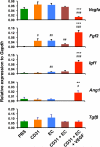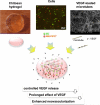Enhanced therapeutic neovascularization by CD31-expressing cells and embryonic stem cell-derived endothelial cells engineered with chitosan hydrogel containing VEGF-releasing microtubes
- PMID: 26102992
- PMCID: PMC4489430
- DOI: 10.1016/j.biomaterials.2015.06.009
Enhanced therapeutic neovascularization by CD31-expressing cells and embryonic stem cell-derived endothelial cells engineered with chitosan hydrogel containing VEGF-releasing microtubes
Abstract
Various stem cells and their progeny have been used therapeutically for vascular regeneration. One of the major hurdles for cell-based therapy is low cell retention in vivo, and to improve cell survival several biomaterials have been used to encapsulate cells before transplantation. Vascular regeneration involves new blood vessel formation which consists of two processes, vasculogenesis and angiogenesis. While embryonic stem cell (ESC)-derived endothelial cells (ESC-ECs) have clearer vasculogenic potency, adult cells exert their effects mainly through paracrine angiogenic activities. While these two cells have seemingly complementary advantages, there have not been any studies to date combining these two cell types for vascular regeneration. We have developed a novel chitosan-based hydrogel construct that encapsulates both CD31-expressing BM-mononuclear cells (BM-CD31(+) cells) and ESC-ECs, and is loaded with VEGF-releasing microtubes. This cell construct showed high cell survival and minimal cytotoxicity in vitro. When implanted into a mouse model of hindlimb ischemia, it induced robust cell retention, neovascularization through vasculogenesis and angiogenesis, and efficiently induced recovery of blood flow in ischemic hindlimbs. This chitosan-based hydrogel encapsulating mixed adult and embryonic cell derivatives and containing VEGF can serve as a novel platform for treating various cardiovascular diseases.
Keywords: CD31(+) cells; Chitosan hydrogel; Embryonic stem cells; Lipid microtubes; Vascular regeneration.
Copyright © 2015 Elsevier Ltd. All rights reserved.
Figures







Similar articles
-
Improvement of postnatal neovascularization by human embryonic stem cell derived endothelial-like cell transplantation in a mouse model of hindlimb ischemia.Circulation. 2007 Nov 20;116(21):2409-19. doi: 10.1161/CIRCULATIONAHA.106.687038. Epub 2007 Nov 5. Circulation. 2007. PMID: 17984381
-
Reversal of endothelial progenitor cell dysfunction in patients with type 2 diabetes using a conditioned medium of human embryonic stem cell-derived endothelial cells.Diabetes Metab Res Rev. 2012 Jul;28(5):462-73. doi: 10.1002/dmrr.2304. Epub 2012 Apr 10. Diabetes Metab Res Rev. 2012. PMID: 22492468
-
Cultured human bone marrow-derived CD31(+) cells are effective for cardiac and vascular repair through enhanced angiogenic, adhesion, and anti-inflammatory effects.J Am Coll Cardiol. 2014 Oct 21;64(16):1681-94. doi: 10.1016/j.jacc.2014.06.1204. J Am Coll Cardiol. 2014. PMID: 25323256 Free PMC article.
-
Human embryonic stem cell-derived vascular smooth muscle cells in therapeutic neovascularisation.J Mol Cell Cardiol. 2011 Nov;51(5):651-64. doi: 10.1016/j.yjmcc.2011.07.014. Epub 2011 Jul 24. J Mol Cell Cardiol. 2011. PMID: 21816157 Review.
-
Vascular differentiation from embryonic stem cells: novel technologies and therapeutic promises.Vascul Pharmacol. 2012 May-Jun;56(5-6):267-79. doi: 10.1016/j.vph.2012.03.007. Epub 2012 Apr 2. Vascul Pharmacol. 2012. PMID: 22504071 Review.
Cited by
-
Surface Engineering of Auxetic Scaffolds for Neural and Vascular Differentiation from Human Pluripotent Stem Cells.Adv Healthc Mater. 2023 Jan;12(6):e2202511. doi: 10.1002/adhm.202202511. Epub 2022 Dec 4. Adv Healthc Mater. 2023. PMID: 36403987 Free PMC article.
-
Exogenous endothelial progenitor cells reached the deficient region of acute cerebral ischemia rats to improve functional recovery via Bcl-2.Cardiovasc Diagn Ther. 2020 Aug;10(4):695-704. doi: 10.21037/cdt-20-329. Cardiovasc Diagn Ther. 2020. PMID: 32968626 Free PMC article.
-
Optimal Environmental Stiffness for Stem Cell Mediated Ischemic Myocardium Repair.Methods Mol Biol. 2017;1553:293-304. doi: 10.1007/978-1-4939-6756-8_23. Methods Mol Biol. 2017. PMID: 28229425 Free PMC article. Review.
-
Fibronectin precoating wound bed enhances the therapeutic effects of autologous epidermal basal cell suspension for full-thickness wounds by improving epidermal stem cells' utilization.Stem Cell Res Ther. 2019 Sep 11;10(1):154. doi: 10.1186/s13287-019-1236-7. Stem Cell Res Ther. 2019. PMID: 31506090 Free PMC article.
-
Preparation of Ion2+-COS/SA Multifunctional Gel Films for Skin Wound Healing by an In Situ Spray Method.Mar Drugs. 2022 Jun 18;20(6):401. doi: 10.3390/md20060401. Mar Drugs. 2022. PMID: 35736204 Free PMC article.
References
-
- Kinoshita M, Fujita Y, Katayama M, Baba R, Shibakawa M, Yoshikawa K, et al. Long-term clinical outcome after intramuscular transplantation of granulocyte colony stimulating factor-mobilized CD34 positive cells in patients with critical limb ischemia. Atherosclerosis. 2012;224(2):440–5. - PubMed
-
- Powell RJ. Update on clinical trials evaluating the effect of biologic therapy in patients with critical limb ischemia. Journal of vascular surgery. 2012;56(1):264–6. - PubMed
-
- Potente M, Gerhardt H, Carmeliet P. Basic and therapeutic aspects of angiogenesis. Cell. 2011;146(6):873–87. - PubMed
Publication types
MeSH terms
Substances
Grants and funding
LinkOut - more resources
Full Text Sources
Other Literature Sources

